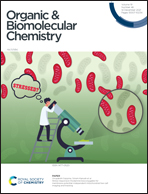Macrocyclic vs. [2]catenane btp structures: influence of (aryl) substitution on the self templation of btp ligands in macrocyclic synthesis†
Abstract
The synthesis of four 2,6-bis(1,2,3-triazol-4-yl)pyridine (btp) olefin based ligands 3, 4, 11 and 12 is described and their attempted use to form mechanically interlocked molecules using ring closing metatheses (RCM) reactions. The btp ligands were modified in two ways, in 3 and 4 the aryl substitution pattern was changed from 4th position to 3rd position and in the case of 11 and 12, the arms were replaced with aliphatic chains. Our study demonstrates that for all four ligands, the RCM reactions only result in the formation of macrocyclic structures, which in three of the cases, were structurally characterised in both solution (using NMR and HRMS) and in the solid-state using X-ray crystallography. NMR studies were also carried out to investigate if these ligands could preorganise in solution via hydrogen bonding interactions. This study provides a handle of how such precursor substitution can be used to direct the formation of macrocycles or mechanically interlocked structures.
![Graphical abstract: Macrocyclic vs. [2]catenane btp structures: influence of (aryl) substitution on the self templation of btp ligands in macrocyclic synthesis](/en/Image/Get?imageInfo.ImageType=GA&imageInfo.ImageIdentifier.ManuscriptID=D1OB02032C&imageInfo.ImageIdentifier.Year=2021)
- This article is part of the themed collection: Supramolecular chemistry in OBC


 Please wait while we load your content...
Please wait while we load your content...